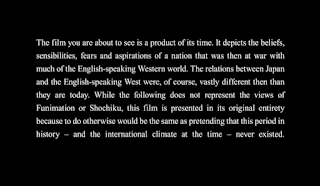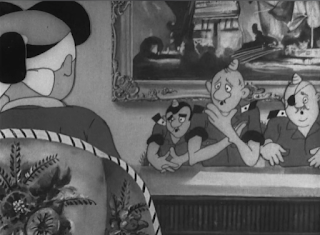Recently, Rightstuf sent me several random anime releases to write reviews for! This is the first of the reviews I will post over the next couple of months. While I did receive these titles for free, that had no influence on my final reviews. Thank you again, Rightstuf, for your support!
Momotaro: Sacred Sailors is an extremely important part of animation history: It was the first feature-length Japanese animated film. It was a product of amazing ingenuity–as supplies were scarce during World War II, celluloids were cleaned in acid to be reused over and over until they started to deteriorate. It ended up being a source of inspiration for both Osamu Tezuka AND Leiji Matsumoto, who both saw it at fairly young ages.
It is also a World War II Propaganda film commissioned by the Japanese Naval Ministry aimed at children.

This concept is nothing new to the world of animation. Most long-time animation fans are familiar with the infamous old Looney Tunes and Disney cartoons of the time, no matter how often both companies may try to bury them in their vaults. While they all have elements that have aged poorly (to put it mildly), they’re still an important chapter in both popular culture and animation history. And Momotaro: Sacred Sailors is no exception. Released at the tail end of World War II, at a time when foreign media was banned by the Japanese government, this allowed animators a chance to get more of their works produced and shown in theaters. And by this point, director Mitsuyo Seo had already done several short works tied to the Navy, which made him an easy choice for heading this film.
I’d been curious about this movie for years, as I’m someone who has loved animation & animation history for as long as I can remember. That was one of the reasons I got into anime in the first place–as a child, I was intrigued by it, because it felt so different from the other cartoons I’d seen. So getting to finally see what the first feature-length anime was like was an exciting prospect, even with its extremely complicated history.
Since the concept of movie length animated features was still a fairly new idea in 1945, the film feels more like 4 connected animated shorts, each focusing on an aspect of these Sailor’s lives during the war. Ultimately, what we get is an idealized, fairy-tale version of wartime life: adorable little animals in Japanese sailor uniforms live in whimsical villages and forests, where the landscapes are pristine, untouched by harsh wartime circumstances. Everyone gets along happily, and everyone works very hard to support their families and communities without a single complaint. And if the title didn’t already make it obvious, the film is very loosely designed around probably
the most well-known Japanese folk tale of all time: Momotaro, the boy who was born from a peach, befriended a talking monkey, dog, and pheasant, and went on a journey together to distant lands to vanquish the evil horned
oni (commonly translated as ogres, demons of Japanese folklore) and return as heroes. In
Momotaro: Sacred Sailors, we see the monkey, dog, and pheasant all as sailors serving in the Navy now, with Momotaro as their brave leader. For a kid’s movie, this makes sense: who better to show leading troops to victory than a folk hero that children would already know and want to cheer for?


What I wasn’t expecting, however, were the moments in the film that felt surprisingly honest for a movie trying to glorify wartime. Early on, there’s a scene of a little Monkey sailor, visiting his family back home in his beautiful little village. While looking over the lush fields, he notices the seeds of some dandelion puffs floating off into the sky on the breeze…and in this imagery, it reminds him of his work as a Naval parachuter. Through him, we hear the familiar sounds of his parachute troop, and the violent sounds of war. We see him close his eyes briefly, as if he’s trying to suppress these memories. It’s a very striking contrast, and an artfully executed scene that hints at the trauma war can cause soldiers. Similarly, later in the film, when the troops in a warplane are getting ready for their big parachute mission, we see rain seeping into the cracks of the dimly lit plane and dripping somberly onto the lowered heads of the sailors, rolling over their faces slowly, as if it were their tears. It’s a scene that feels genuinely full of fear and sorrow, giving these nameless animal soldiers a moment of humanity before the film quickly goes back to encouraging us to root for our plucky heroes.
Overall, the film is quite a feat for it’s time. Even though it was done in black & white, the use of light and shading is very well executed, especially during times when characters are walking through the woods. Shadows from light falling through the tree’s leaves pass over the animals as they walk, their mouths animated incredibly fluidly as they talk and sing. The use of a multiplane camera lets the film show impressive depth of field in the animal’s lavishly cartoony, animated world. Stylistically, it’s very different from what we think of as “anime” now. It’s much more heavily informed by the animation of the time that the animators were obviously inspired by: Van Beuren, Disney, Fleischer, all the greats. Fleischer’s influence is especially noticeable when Momotaro & his troops successfully capture their foreign enemies, including 2 men that look exactly like Bluto and Popeye–complete with spinach can.

Speaking of foreigners, the film keeps the Momotaro folktale aspect running by portraying the British (and possibly American?) captured officials as–what else--evil horned oni, straight from the original Momotaro story. It’s surprising to hear them speak with what appears to be native British English voices in the film…Some scholars speculate there’s a chance that the voice could be from a prisoner of war who was forced to record dialog. Others suggest that a stranded expat could have signed up for the job for money, knowing that no one would ever know they were involved. Either way, it’s a fascinating mystery that adds yet another eerie layer to the film.
It really is a shame that the credits of this movie are so sparse; and due to the war and the film’s age, elements and documentation of the making of this movie are pretty much long gone. While there’s not a lot of extras in this release, there’s a fairly lengthy booklet that comes with the bluray/DVD set with some fantastic insight by independent anime scholar Helen McCarthy, and historical notes by researcher Mika Tomita that gives a lot of context to this release. The main on-disc extra this release does have is another short by Kenzo Masaoka, one of the key animators on Momotaro: Sacred Sailors, called The Spider and The Tulip. While the short is beautifully animated, it too suffers from elements of the era. Specifically, the villain of the short, the Spider, being animated in a racist caricature of a singing, predatory black man. It’s not comfortable to watch, but a timely reminder that these hurtful racial stereotypes weren’t just limited to American animation.
It’s hard to really pinpoint my definitive feelings on this film. It’s amazing to be able to see such an old, historically significant piece of animation on bluray–the restoration is pretty fantastic, giving new life to a movie that was only previously ever available in fuzzy, too-dark VHS releases nearly 40 years ago. Watching this bluray, it’s no surprise that it ended up being influential to Japanese artists who saw it as children. The animation is legitimately beautiful at times, and charming overall, giving us a glimpse at how Japan would continue to harness the power of cute characters to tell stories and sell products in the future. Some of the musical numbers are actually kind of catchy, specifically the “A E I O U” song, when one of Momotaro’s troops is teaching animals from a foreign island they’ve occupied the Japanese katakana alphabet. And I appreciate the films’ momentary breaks from the Disney-like cheeriness to give us flashes of what war might have actually felt like to those Naval parachute troops. But ultimately, everything is portrayed a little too happily, a little too perfectly. There’s no denying that this is 100% a war propaganda film. While technically and artistically impressive, and historically incredibly important, I find myself hard pressed to think of the next time I might want to watch this movie again for “fun”, outside of for research purposes. If you’re a history buff, an animation history fan, or just want to see where theatrical anime began, it’s absolutely worth a watch if you feel you can stomach such a film. But for a more casual anime fan who comes to anime for, say, escapist entertainment rather than for history lessons, I can see it sounding completely unappealing. If you have a Funimation streaming subscription, I believe it’s still available for streaming there, which is a good option if you don’t want to just buy the physical release sight unseen.
But for those who want to add this piece of anime’s complex history to their physical media collection, it’s still currently for sale at Rightstuf’s online store. Big thanks to Rightstuf for sending me a copy of this film to review!
You can use my affiliate link here to purchase a copy of it (or anything in their store!), and toss a few cents my way. If you appreciated this review, you can also leave me a tip of any size on
my ko-fi account here!
Thanks for reading!






No comments:
Post a Comment